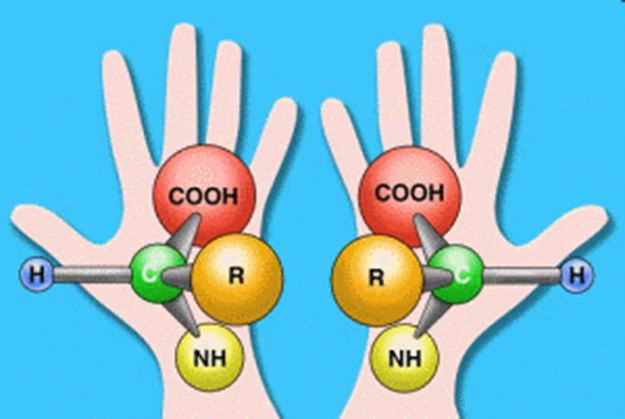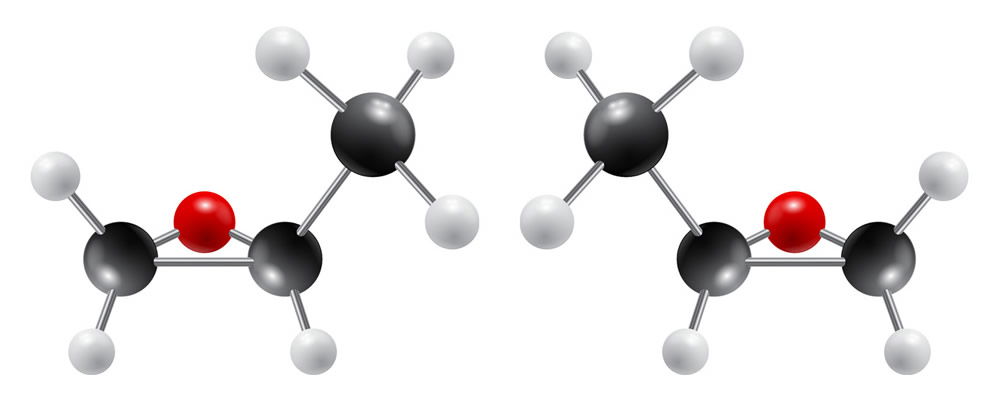
Chiral Molecule in Interstellar Cloud Said to Shed Light on Life’s Origins
News to Know
Abstract
Mirrored molecules out in space, did you start the human race?
News Source
- Science Daily: “Life’s First Handshake: Chiral Molecule Detected in Interstellar Space”
- Chemical & Engineering News: “Chiral Molecule Found in Interstellar Cloud: Interstellar Propylene Oxide Could Shed Light on Life’s Handedness”
Just as your hands are mirror images of each other, many carbon-containing molecules exist in non-superimposable mirror-image forms. Such compounds are called chiral—pronounced kīrəl, like spiral with a k. Chiral compounds from non-biological sources generally consist of equal proportions of left- and right-handed forms. But the biochemistry that builds chiral molecules in living organisms is curiously special: it produces a single, specific, mirror-image form. Biochemical processes require a particular mirror-image form of each chiral molecule to function properly. Life’s chemistry is therefore called homochiral.

Just as your hands are mirror images of one another, so many molecular components and products of living things exist in non-superimposable mirror-image forms. These are called chiral [kīrəl] molecules. But unlike your hands, the chiral molecules used by each biochemical process in your body—and every other form of life—are present in only one of their two chiral forms. For instance, in this illustration the basic model of an amino acid is depicted in mirror-image forms. But only left-handed amino acids are incorporated into proteins. How living things manage to produce only a single chiral form is a great mystery to evolutionists.
Though they are homochiral, not all chiral molecules produced by biological sources are left-handed. For instance, oranges consistently make one chiral form of limonene in their peeling while lemons make the other form, imparting different smells to these citrus fruits. Plants produce only right-handed monosaccharides like glucose, and this is the chiral form used to build the carbohydrates in our bodies. How all living things acquired not only the property of homochirality but also the ability to produce such matching homochiral forms has long been a mystery to evolutionists. Because some chiral molecules would have to have been present before evolutionary selection could somehow “choose” one handed form over another, chiral molecules would be essential components of the supposed “prebiotic” chemical toolkit. Many evolutionists believe that “stardust” seeded planets with the chemical building blocks of life wherever it evolved.1 Therefore, astronomers who recently discovered an interstellar chiral molecule believe they have found the key to unlock the evolutionary mystery of life’s homochirality.
The Chemical Seeds of Life?
Brett McGuire of the National Radio Astronomy Observatory in Charlottesville, Virginia, lead author of the report published in Science, says, “This is the first molecule detected in interstellar space that has the property of chirality, making it a pioneering leap forward in our understanding of how prebiotic molecules are made in the Universe and the effects they may have on the origins of life.”2 Thus far it has not been possible to determine whether the chiral forms of propylene oxide—the molecule McGuire’s team discovered—are present in equal amounts or not. Nevertheless, it is the first chiral molecule found in outer space. “Propylene oxide is among the most complex and structurally intricate molecules detected so far in space,” coauthor Brandon Carroll explains. “Detecting this molecule opens the door for further experiments determining how and where molecular handedness emerges and why one form may be slightly more abundant than the other.”3
The propylene oxide’s radio spectrum was detected near the center of our galaxy in the interstellar cloud Sgr B2(N). The three carbon atoms, six hydrogen atoms, and one oxygen atom comprising each molecule of propylene oxide can also be arranged in other ways—as the molecules propionaldehyde and acetone—which are not chiral.4 These non-chiral molecules are also found in this interstellar cloud.5 But the two possible arrangements of the atoms in propylene oxide are non-superimposable mirror images of each other. Each of the mirrored forms has the same spectrum, so it is not possible as yet to tell whether the forms exist in unbalanced amounts. Mixtures of equal proportions are usual in chiral products not formed by living things. And while the researchers expect in the future to determine this by seeing how the molecules react to polarized light, just the existence of a chiral molecule is seen as a step toward discovering the origin of the homochirality on which the chemistry in living things depends.
Chiral Chemistry in Space: Key to Evolutionary Biology?
Chemically there are a number of scenarios that could produce some imbalance in the amount of the two forms of a chiral molecule in the absence of living organisms. For instance, fragments of the Tagish Lake meteorite that fell over British Columbia in 2000 contained a preponderance of left-handed amino acids. Such left-handed molecules are the chiral form associated with life, but the fragments contained no other evidence of life. Three amino acids in that meteorite exist as chiral forms. Two of these—aspartic acid and glutamic acid—were not present in the expected 50-50 proportions generally seen in nonliving systems. A third, alanine, was. The team that discovered this chiral imbalance realized that only the left-handed forms of aspartic acid and glutamic acid can arrange themselves as crystals after being dissolved in water, whereas both forms of alanine can crystallize. They suggested that at some point in its history the meteorite’s amino acids were dissolved in water and then, upon loss of the water, greater amounts remained of those amino acids that could crystallize.

These are models of propylene oxide, the first chiral molecule discovered in interstellar space. Researchers do not yet know if the left- and right-handed forms, like those depicted here, exist in balanced amounts in the interstellar cloud or in the unbalanced proportions evolutionists believe could somehow evolve into life. Image by Hannah Ahern, Answers in Genesis.
Chiral chemicals produced by or useful to living organisms, however, cannot be just a little unbalanced. They must be 100% homochiral. Evolutionists believe that if, once upon a time, there existed even a small excess of one chiral form over another, random natural processes and natural selection would have ultimately evolved the homochirality found in life. Of course this presupposes that life could evolve from a batch of chemicals through random natural processes, something for which there is no experimental scientific evidence. (Learn more about this in “Sutter’s Mill Meteorite Harbors a Wealth of Elusive Organics” and “Attempts to Trace Life Back to Chemical Origins Still Maps the Willful Ignorance of the Hunters.”)
Notwithstanding the lack of evidence that abiogenesis—the evolution of life from nonlife—could ever happen, the discovery of a complex chiral molecule in outer space is being hailed as the first step toward revealing the mysterious origin of homochirality. The researchers believe that interstellar clouds eventually condense into solar systems; therefore, the discovery of a chiral molecule is believed to be a way that the prebiotic chiral chemicals, from which life evolved, could have gotten their start.
Primordial Soup on Primordial Planets
Beyond the numerous leaps of presumption associated with the idea that chemicals could evolve into life in the first place, the researchers are basing their claims about the significance of their discovery on an additional set of unverifiable assumptions: the notion that stars and the planets around them form from clouds like the one in which the propylene oxide was discovered. The commonly accepted “nebular hypothesis” supposedly explains how our own solar system formed 4.6 billion years ago from a cloud of dust and gas. Answers in Genesis astronomer Dr. Danny Faulkner explains,
Evolutionary theories of astronomy suggest that the solar system formed from a cloud of gas and dust. . . . Supposedly, most of the material in the cloud collapsed to the center to form the sun, while the remaining material flattened into a disk. Within that disk, small particles supposedly began to stick together. Just how these particles stuck together is not known. Eventually, some of these particles (called planetesimals) grew large enough so that their gravity attracted other planetesimals. This slow process of amalgamation eventually resulted in the bodies of the solar system, the planets, their satellites, asteroids, and comets.
But gas clouds do not spontaneously contract. As Dr. Faulkner points out, “There are many pieces of this theory that are unknown, such as how the contraction process started, and how the small particles began to stick together.” Yet the leap to insert the interesting discovery of a chiral chemical in an interstellar cloud into the ingredients list for life’s evolutionary recipe jumps right past the problems with the whole solar-system-evolution scenario, optimistically looking for a solution to the homochirality mystery.
Organically Grown?
Organic compounds—molecules containing carbon—can form independent of living organisms. Some of the molecules that cells manufacture using enzyme-mediated chemistry can be synthesized in laboratories by the average chemistry student or even in the completely intelligence-free environment of a carbon-containing meteorite. Amino acids, nucleobases similar to the building blocks of RNA and DNA, chemicals commonly associated with glucose metabolism,6 and even, as mentioned above, a non-biologic, left-handed imbalance of chiral molecules have been found in meteorites.
Could the mere presence of those building blocks get life going on earth?
Evolutionists imagine that life’s chemical building blocks were found on our primordial planet or rained in from outer space. But could the mere presence of those building blocks get life going on earth? By way of analogy, consider a bucket of nails, magnets, wire coils, and washers. Some of these will, as a result of their natural properties, be attracted to each other. Add electricity to the coils of wire, and even more items orient in some sort of order. But they do not self-assemble into a primitive, functional device, much less a self-replicating one. The natural processes operating on these random components could not infuse them with the information to become a complex tool, much less one that can duplicate itself as living things do.
The mere existence of some necessary components for life, even if located on an ancient earth, would not explain the origin of life. The existence of chemical building blocks, like chiral molecules, does not make it scientifically possible to backtrack life to its presumed chemical origins. The radio telescopes have revealed more about the chemicals in space, but not a roadmap to life’s past.
Nothing in experimental science has ever shown that life could randomly emerge from nonliving components through natural processes. Biological observations demonstrate that life only comes from life. And despite claims that information can emerge from random chemical processes, observational science affirms that the genetic information essential to life must come from a source of information and does not spring into existence on its own, no matter what building blocks are around. God in His Word reports that He—our Creator—created all kinds of life about 6,000 years ago, during the same week that He spoke our planet and all the universe’s stars into existence. There is no scientific evidence that either planetary evolution or molecules-to-man evolution ever happened. This discovery tells us nothing about the origin of life. Our Creator God, the only eyewitness to the events of our origins, is the only reliable source of truth about where we came from, and He has told us life’s real history in His Word.
Further Reading
- Meteorite Complicates Search for Life in Space
- Cosmos Review: “Some of the Things Molecules Do”
- Attempts to Trace Life Back to Chemical Origins Still Maps the Willful Ignorance of the Hunters
- Did Life Come from Outer Space?
- Sutter’s Mill Meteorite Harbors a Wealth of Elusive Organics
For More Information: Get Answers
Remember, if you see a news story that might merit some attention, let us know about it! (Note: if the story originates from the Associated Press, FOX News, MSNBC, the New York Times, or another major national media outlet, we will most likely have already heard about it.) And thanks to all of our readers who have submitted great news tips to us. If you didn’t catch all the latest News to Know, why not take a look to see what you’ve missed?
(Please note that links will take you directly to the source. Answers in Genesis is not responsible for content on the websites to which we refer. For more information, please see our Privacy Policy.)
Footnotes
- Dr. Ronald Breslow, who published a paper about the chemistry needed to produce homochiral products from the slightly unbalanced chiral mixtures found in some meteorites, summed up the truth about the notion that chemicals could evolve to produce life when he commented that there is no way such “building blocks could assemble into structures with the exciting properties of life.” Ronald Breslow, “Evidence for the Likely Origin of Homochirality in Amino Acids, Sugars, and Nucleosides on Prebiotic Earth,” Journal of the American Chemical Society 134, no. 16 (2012): 6887–6892, doi:10.1021/ja3012897. Dr. Breslow’s paper was withdrawn on May 16, 2012.
- “Life’s First Handshake: Chiral Molecule Detected in Interstellar Space,” Science Daily, June 14, 2016, https://www.sciencedaily.com/releases/2016/06/160614142127.htm.
- Ibid.
-
Propionaldehyde, acetone, and propylene oxide are structural isomers of each other. They each contain the same assortment of atoms connected in different ways. Each arrangement has distinctly different chemical properties and different spectra. They can therefore be distinguished by astronomers using radiotelescopic analysis of their spectra.
The two forms of a chiral molecule, like propylene oxide, however, are called enantiomers. The bonds between the atoms are essentially the same, except that they are mirror images of each other. Such enantiomers have the same melting, boiling, and freezing points. They also have the same spectral characteristics. Therefore, astronomers have not yet been able to distinguish them. They may in the future be distinguished, however, by the differing ways they react to any polarized light in their interstellar neighborhood. - Brett A. McGuire et al., “Discovery of the Interstellar Chiral Molecule Propyleneoxide (CH3CHCH2O),” Science 352, no. 6292 (2016): doi:10.1126/science.aae0328.
- George Cooper et al., “Detection and Formation Scenarios of Citric Acid, Pyruvic Acid, and Other Possible Metabolism Precursors in Carbonaceous Meteorites,” Proceedings of the National Academy of Sciences 108, no. 34 (2011): 14015–15210, doi:10.1073/pnas.1105715108.
Recommended Resources

Answers in Genesis is an apologetics ministry, dedicated to helping Christians defend their faith and proclaim the good news of Jesus Christ.
- Customer Service 800.778.3390
- © 2024 Answers in Genesis



